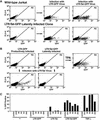HIV reproducibly establishes a latent infection after acute infection of T cells in vitro
- PMID: 12682019
- PMCID: PMC154479
- DOI: 10.1093/emboj/cdg188
HIV reproducibly establishes a latent infection after acute infection of T cells in vitro
Abstract
The presence of latent reservoirs has prevented the eradication of human immunodeficiency virus (HIV) from infected patients successfully treated with anti-retroviral therapy. The mechanism of postintegration latency is poorly understood, partly because of the lack of an in vitro model. We have used an HIV retroviral vector or a full-length HIV genome expressing green fluorescent protein to infect a T lymphocyte cell line in vitro and highly enrich for latently infected cells. HIV latency occurred reproducibly, albeit with low frequency, during an acute infection. Clonal cell lines derived from latent populations showed no detectable basal expression, but could be transcriptionally activated after treatment with phorbol esters or tumor necrosis factor alpha. Direct sequencing of integration sites demonstrated that latent clones frequently contain HIV integrated in or close to alphoid repeat elements in heterochromatin. This is in contrast to a productive infection where integration in or near heterochromatin is disfavored. These observations demonstrate that HIV can reproducibly establish a latent infection as a consequence of integration in or near heterochromatin.
Figures





References
-
- Antoni B.A., Rabson,A.B., Kinter,A., Bodkin,M. and Poli,G. (1994) NF-κB-dependent and -independent pathways of HIV activation in a chronically infected T cell line. Virology, 202, 684–694. - PubMed
-
- Butera S.T. (2000) Therapeutic targeting of human immunodeficiency virus type-1 latency: Current clinical realities and future scientific possibilities. Antiviral Res., 48, 143–176. - PubMed
-
- Butler S.L., Hansen,M.S. and Bushman,F.D. (2001) A quantitative assay for HIV DNA integration in vivo. Nat. Med., 7, 631–634. - PubMed
Publication types
MeSH terms
Substances
Grants and funding
LinkOut - more resources
Full Text Sources
Other Literature Sources
Medical
Research Materials

